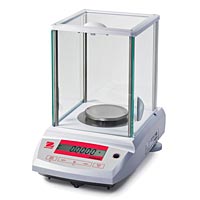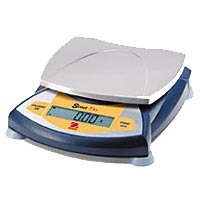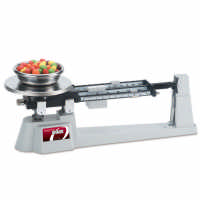Balances: Choose and Use Guide Generally speaking, balances and scales are used for measuring the weight of a sample and determining its mass. There are several different types of balances and scales:
- Mechanical Balances – triple beam, dual pan, primary school balances
- Digital Balances – top loading, analytical, dual range
- Spring Scales – linear, rotary dial, platform, bathroom scales
  
There are many different measuring units to choose from as well. In the United States, we have been using the old English system of pounds and ounces for commerce, while most laboratory measurements would require the metric system of grams. Most physics applications, where force is being determined, would use Newtons as the unit of measure. Mechanical balances are probably the oldest form of weighing device in existence. They rely on a comparison between a known weight and the unknown sample, which are "balanced" on opposite pans. Newer versions of this type of balance use a single pan for the unknown sample, which is measured by sliding weights along several calibrated beams. The capacities of these balances range from about 600 grams to about 2600 grams. The readability (or resolution) is generally one tenth of a gram. They are rugged and durable, and generally accurate enough for educational uses. Since they use moving parts to literally balance the measurement, they will eventually need to be serviced for wear and tear. Electronic digital balances use strain gauge type load cells to measure mass. As a weight is applied to the load cell, the electric resistance of the load cell changes. By measuring this change, the mass of the sample can be accurately determined. There are many models and features to choose from, but it doesn’t have to be a confusing and frustrating process if you can define your needs and match them with the proper balance. Here are some of the things you should consider when choosing a weighing device: Range – Also known as capacity, this is the maximum weight that the balance can measure. Putting more than the recommended mass on a digital balance can have catastrophic results. You should be careful to pick a model that exceeds the maximum weight you anticipate having to measure. On the other hand, you don’t want to choose a model that has too much capacity, because cost becomes a factor when you combine a higher range with the resolution you require. Resolution – Also known as readability, this is the increment that the balance will read in. The mechanical balances previously described have a resolution of 0.1 grams. Sargent Welch currently sells electronic balances that have a resolution as fine as 0.1 milligrams. Some of our more economical models have a resolution of 1 gram. Choose a balance that has the resolution that will meet your weighing needs. Accuracy – Sometimes stated as linearity, this is the error factor that a balance or scale may have. It is expressed as a +/- variation from the reading that the scale or balance may give under ideal weighing conditions. Other factors such as vibration or air currents may adversely affect your readings beyond the stated accuracy. Tare – Perhaps the most widely misunderstood feature of a balance or scale is the tare function. Simply put, tare allows the user to zero the instrument to cancel the weight of a container (such as a weighing dish or plastic bag) from the reading of the instrument, thus giving the true weight of the product being tested. Without tare, it would be necessary to manually subtract the weight of the container from the displayed value. Tare does not increase the capacity of a scale or balance, however. If you are using a balance with a 100 gram maximum capacity and you place a 10 gram weighing dish on the pan and tare it, you are left with only 90 grams of capacity to do your weighing. Remember- it is an unsafe practice to overload any weighing device! Serious damage to your balance or scale will almost certainly result from overloading it. Digital balances have a push button for tare, and some mechanical balances use a tare beam or screw adjustment to rebalance the instrument back to zero. Hanging scales rely on a spring constant to make the measurement, and may have a sliding faceplate or screw adjustment for tare. Units – Most of the balances we sell weigh primarily in grams. The electronic balances may also have other units as well, such as ounces, pounds, ozt (pennyweight), and Newtons. Most laboratory applications would use grams or milligrams. Force measurement in the physics lab would probably be done in Newtons. Dietetic and bathroom scales measure in ounces or pounds. Draft shields are available with many of our sensitive analytical balances to shield the weighing pan from air currents. Most balances have lock-down devices available to deter theft, and most come standard with an AC adapter for use with 110/120VAC. Many electronic balances can be battery-operated for increased portability. RS-232 allows the balance to be interfaced with a PC. This allows the user to capture readings right onto a computer, and with some models the user can actually control the balance through their PC. This generalized description of scales and balances is intended solely as a guide for selecting a weighing device, and is not intended to replace or supercede the manufacturer’s instructions for the use of any specific product. Questions about the use and maintenance of a product should be directed to the manufacturer.
|
